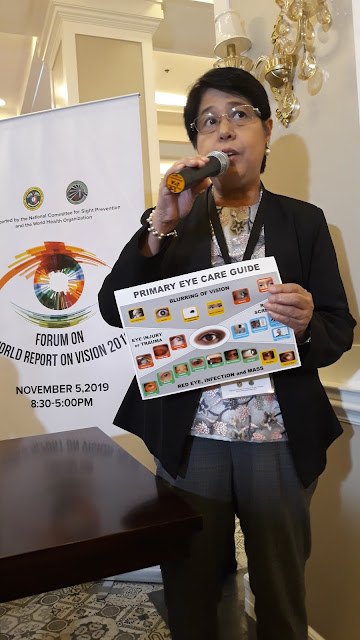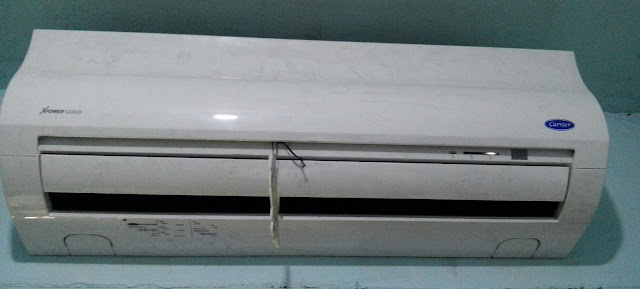Universal Health Care Now Covers Eye Health Services!
Hello po! Frens, last November 5 was the Forum on World Health Report on Vision 2019. This was held by the Department of Health (DOH) and PERI (Philippine Eye Research Institute), supported by the World Health Organization (WHO) and National Committee for Sight Preservation (NCSP). I attended the presscon which happened in Rizal Park Hotel in Manila. The findings and recommended action plan of the report was discussed.
An estimated 2.2 billion people around the world suffer from vision impairment. Yet the first World Health Report on Vision, recently by the World Health Organization (WHO), reveals that half of them, or about 1.1 billion, do not receive the care they need for conditions like near and far sightedness, glaucoma, and cataracts.
Based on the 2018 Philippine National Blindness Survey and Eye Disease Study conducted by the Philippine Eye Research Institute of the National Institute for Health, vision impairment and blindness rank among the major concerns in the country with a current prevalence rate of 1.98%. This represents 1.11 million Filipinos with cataract, 400,000 with uncorrected error of refraction, almost 300,000 with glaucoma, and 200,000 with maculopathy.
Additionally, there are over 4 million Filipinos living with undiagnosed eye problems that need to be addressed.
Although the prevalence of bilateral blindness due to cataracts and errors of refraction has decreased in the past years, there are still thousands of Filipinos with moderate to severe vision impairment.
“We are fortunate that these diseases can be treated with surgery or prescription eyeglasses. These can also be easily prevented with regular consumption of Vitamin A, injury prevention, and immunization for measles and rubella that cause vision impairment,” Health Secretary Francisco Duque emphasized.
In line with the Universal Health Care (UHC) Law, the Department of Health (DOH) is gearing toward providing comprehensive eye care services, integrating eye care within local health systems, and responding to emerging eye diseases such as diabetic retinopathy and glaucoma.
“Through the primary care provider network that will be institutionalized under UHC, we hope to bring easy access and seamless referral to ophthalmic units, comprehensive eye centers, and national ophthalmic specialty centers. These health facilities will be capacitated to deliver the appropriate eye care services,” Duque explained.
The country’s Prevention of Blindness Program is revamped with the issuance of revised policies, aligning the program with UHC and WHO’s goal of universal eye health, while ensuring that it remains responsive to the changing trends in blindness and visual impairment.
“The DOH is fully committed to working with our partners to address blindness and visual impairment in our country. Together, we can achieve our vision of Filipinos enjoying the right to sight, with no one going needlessly blind or visually-impaired,” the Health Chief concluded.
Director Ruby Constantino, Director of DPCB of DOH, was in place of Secretary Duque.
Eye health should be taken seriously! I was fortunate that my parents could afford my eyeglasses and contact lens, which I had needed to wear since I was 15 years old- that's about 20 years ago! My younger brother, on the other hand, only got diagnosed with lazy eye when he was applying for a job; he kept it a secret! Even my niece (child of my in-law), at two years old, needed intervention since she is showing symptoms, and being cross-eyed ran in their family! Now with this to be covered by the UHC, plus the addition of new policies, there certainly should be no reason one cannot have appropriate treatment to manage eye diseases and prevent loss of sight. :)
An estimated 2.2 billion people around the world suffer from vision impairment. Yet the first World Health Report on Vision, recently by the World Health Organization (WHO), reveals that half of them, or about 1.1 billion, do not receive the care they need for conditions like near and far sightedness, glaucoma, and cataracts.
L-R: Dr. Andreas Mueller (Regional Advisor, WHO Collaborating Centre for Prevention of Blindness), Dr. Leo Cubillan (Director, PERI), and Ms. Aurora Banda-Alfonso (DOH), who moderated the Q&A.
Based on the 2018 Philippine National Blindness Survey and Eye Disease Study conducted by the Philippine Eye Research Institute of the National Institute for Health, vision impairment and blindness rank among the major concerns in the country with a current prevalence rate of 1.98%. This represents 1.11 million Filipinos with cataract, 400,000 with uncorrected error of refraction, almost 300,000 with glaucoma, and 200,000 with maculopathy.
Additionally, there are over 4 million Filipinos living with undiagnosed eye problems that need to be addressed.
Although the prevalence of bilateral blindness due to cataracts and errors of refraction has decreased in the past years, there are still thousands of Filipinos with moderate to severe vision impairment.
On the Philippine National Survey of Blindness and Eye Disease Study Project.
“We are fortunate that these diseases can be treated with surgery or prescription eyeglasses. These can also be easily prevented with regular consumption of Vitamin A, injury prevention, and immunization for measles and rubella that cause vision impairment,” Health Secretary Francisco Duque emphasized.
Dr. Maria Rosario Sylvia Uy (Program Manager, Prevention of Blindness Program, DOH) speaks about the Primary Eye Care Guide.
In line with the Universal Health Care (UHC) Law, the Department of Health (DOH) is gearing toward providing comprehensive eye care services, integrating eye care within local health systems, and responding to emerging eye diseases such as diabetic retinopathy and glaucoma.
Dr. Ella Cecilia Naliponguit (Director III, School Health Division, DepEd) talks about the National Vision Screening Program for Kindergarten Pupils.
“Through the primary care provider network that will be institutionalized under UHC, we hope to bring easy access and seamless referral to ophthalmic units, comprehensive eye centers, and national ophthalmic specialty centers. These health facilities will be capacitated to deliver the appropriate eye care services,” Duque explained.
The country’s Prevention of Blindness Program is revamped with the issuance of revised policies, aligning the program with UHC and WHO’s goal of universal eye health, while ensuring that it remains responsive to the changing trends in blindness and visual impairment.
“The DOH is fully committed to working with our partners to address blindness and visual impairment in our country. Together, we can achieve our vision of Filipinos enjoying the right to sight, with no one going needlessly blind or visually-impaired,” the Health Chief concluded.
Me and fellow bloggers flank Ms. Karen Davila, Moderator for the Panel Discussion.
Director Ruby Constantino, Director of DPCB of DOH, was in place of Secretary Duque.
Eye health should be taken seriously! I was fortunate that my parents could afford my eyeglasses and contact lens, which I had needed to wear since I was 15 years old- that's about 20 years ago! My younger brother, on the other hand, only got diagnosed with lazy eye when he was applying for a job; he kept it a secret! Even my niece (child of my in-law), at two years old, needed intervention since she is showing symptoms, and being cross-eyed ran in their family! Now with this to be covered by the UHC, plus the addition of new policies, there certainly should be no reason one cannot have appropriate treatment to manage eye diseases and prevent loss of sight. :)









Comments
Post a Comment
Hello and welcome , friend! Thank you for visiting my blog! Please leave your lovely thoughts below! I would be glad to get back to you as soon as possible!